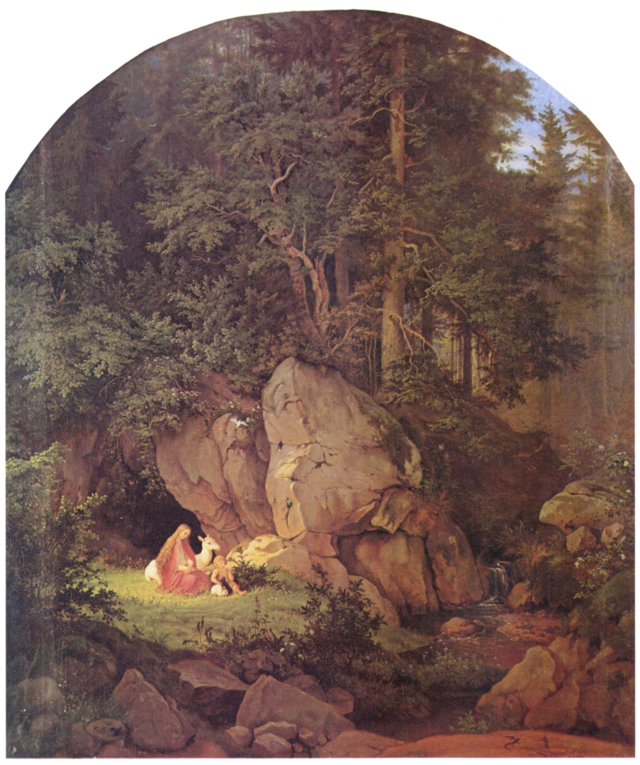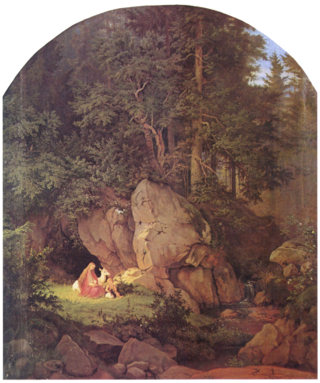Top Qs
Timeline
Chat
Perspective
German Forest
Setting in 19th century German Romanticism From Wikipedia, the free encyclopedia
Remove ads
The German Forest (German: Deutscher Wald) was a phrase used both as a metaphor as well as to describe in exaggerated terms an idyllic landscape in German poems, fairy tales and legends of the early 19th-century Romantic period. Historical and cultural discourses declared it as the symbol of Germanic-German art and culture, or as in the case of Heinrich Heine or Madame de Staël, as a counter-image of French urbanity. It was also used with reference to historical or legendary events in German forests, such as Tacitus' description of the Battle of the Teutoburg Forest or even the nature mysticism of the stylized Germanic national myth, the Nibelungenlied as the history of its multi-faceted reception shows.[1]



The early conservation and environmental movement, the tourism that was already under way in the 19th century, the youth movement, the social democratic Friends of Nature, the Wandervögel youth groups, the hiking clubs and the right-wing Völkisch movement saw in forests an important element of German cultural landscapes.
Remove ads
State-controlled forests
Nachhaltigkeit is the German principle for sustainability, which has been used throughout history and is at the core values of German forestry as a whole.[2] Nachhaltigkeit is what the German forests are famous for throughout the globe, and in terms of environmental practices. German forests in particular through the 19th century had state-issued guards in the forests across Germany, limiting access to citizens in order to preserve resources.[3] This practice helped cut down on deforestation, though like the majority of the western world at this time, did not completely work.[2] This was partly due to the extensive manicuring of the forests, including the rigid structure of growing trees in rows and clearing any underbrush. This weakened the natural ecosystem of the forests, and made the trees more prone to pests and disease.[4]
Remove ads
Literature
Germany's strict control over its forests allowed for the ideal of German romantic forests, that were idolized and used in literature to show the beauty and magic of nature.[5] Many fairy tales have been inspired by the German forests, such as works from Brothers Grimm and Herder. Musicians such as Johannes Brahms, Richard Wagner, and Franz Schubert have also written works about German forests. Core ideas in these writings are love for Germany and the forests, unity, brooding, and magic. It can be said that these themes showed unity for Germany as a whole, while describing the forests similarly.[6] The setting for these fairy tales are commonly the Black Forest of Germany, though the location of other fairy tales can vary in Germany's many forests.
Remove ads
Nazi regime
During the Nazi regime, the idea of conservationism for German forests coincided with the Nazi propaganda attacking liberal values. The Nazis used the phrase Naturgemäße Waldwirtschaft ("forestry according to nature") to explain that they were merely restoring Germany back to its purest form.[7] Many minorities would hide in the forests for protection from those less familiar with the land, and Hitler called the forest a hiding place for weak ethnic groups.[8] Even so, the Nazi regime tried to protect German forests and saw them as a symbol of national excellence in their purity. But the Nazi conservation efforts were undermined by military plans.[9]
In Nazi ideology, the motif of the "German Forest" was comparable to their "Blood and Soil" slogan, a typical Germanic symbol. Propaganda, political symbolism and landscape planning drew on this as a central theme for the period after a German victory.[10]
Recent times
Albrecht Lehmann has postulated a continuity of romantic forest idealism in the German peoples, transcending class and generation, from the Romantic period through the 21st century.[11] Examples of the intense and distinctive handling of the cultural forest include the discussion of environmental damage and forest dieback, and the forms of commemoration and mourning associated with woodland cemeteries and natural burials.[12]
Polls identify a uniquely German concept of the equivalence of forest and nature. The forest as an educational medium and healthy environment, in the context of environmental education,[13] has a particular significance in the German-speaking region (see also forest education and forest kindergarten).
Remove ads
See also
References
Literature References
External links
Wikiwand - on
Seamless Wikipedia browsing. On steroids.
Remove ads
